Smartglove birth help tested
 Experts say that a cheap smartglove could reduce birth complications.
Experts say that a cheap smartglove could reduce birth complications.
A US$1 (AU$1.40) smart glove that transmits data about the foetus during vaginal examinations could reduce dangerous births, according to international researchers.
Engineers have created a device to assist healthcare staff in identifying foetal position and the force applied to the foetal head during labour, factors that can contribute to obstructed labour and poor birth outcomes.
The technology can provide real-time data during vaginal examinations, potentially improving birth outcomes in low-resource regions.
When labour is not going as it should, clinicians can use a wide array of medical technologies to determine what is wrong. However, in low- and middle-income countries, these technologies and skilled staff who can use them are not always available.
The researchers behind this latest study reported that 98 per cent of stillbirths occur in such countries, reflecting the cost of this problem.
The researchers began with a simple surgical glove as the basis for the new technology.
They printed flexible pressure and force sensors onto the glove’s fingertips. These sensors consist of metal-oxide nanocomposites that can generate an electric current when touching or rubbing against objects.
Cleverly, the researchers ensured that the sensors were thin enough that they would not interfere with a doctor’s sense of touch.
A second surgical glove can be worn over the team’s glove, to keep things sterile in the vaginal cavity.
The researchers also developed a smartphone app, which allows clinicians to view the sensor data in real time. Each sensing glove costs less than $1 to produce.
To test the system, the researchers created models of a baby’s head from a silicone elastomer, which replicated the delicate surface structures of the real thing.
An experienced obstetrician performed mock vaginal examinations using the sensing glove and silicone heads, to test whether the system could identify features that would indicate the foetal position and measure the force applied to the head.
The sensing glove successfully indicated the joints between the ‘bones’ of the model heads with a jump in electrical current as the glove’s finger passed over them.
This would allow a clinician to determine where these joints are, and therefore calculate the orientation of the foetus.
The glove also successfully sensed the force applied to the heads, providing real-time data on the smartphone app.
The researchers plan to conduct trials in humans to determine whether the glove can provide the same information in real-world conditions.
If successful, the technology could provide a simple and inexpensive early-warning system for obstructed birth in low-resource regions of the world. It may also act as a valuable training tool for clinicians in such regions.
“This is the first glove of its kind that could be used to identify foetal position and therefore may be able to improve labour outcomes,” says Dr Shireen Jaufuraully of University College London, lead author on the study.
“We hope that with successful clinical translation, the glove may be used worldwide, increasing the safety of assisted vaginal birth.”
The study is accessible here.








 Print
Print